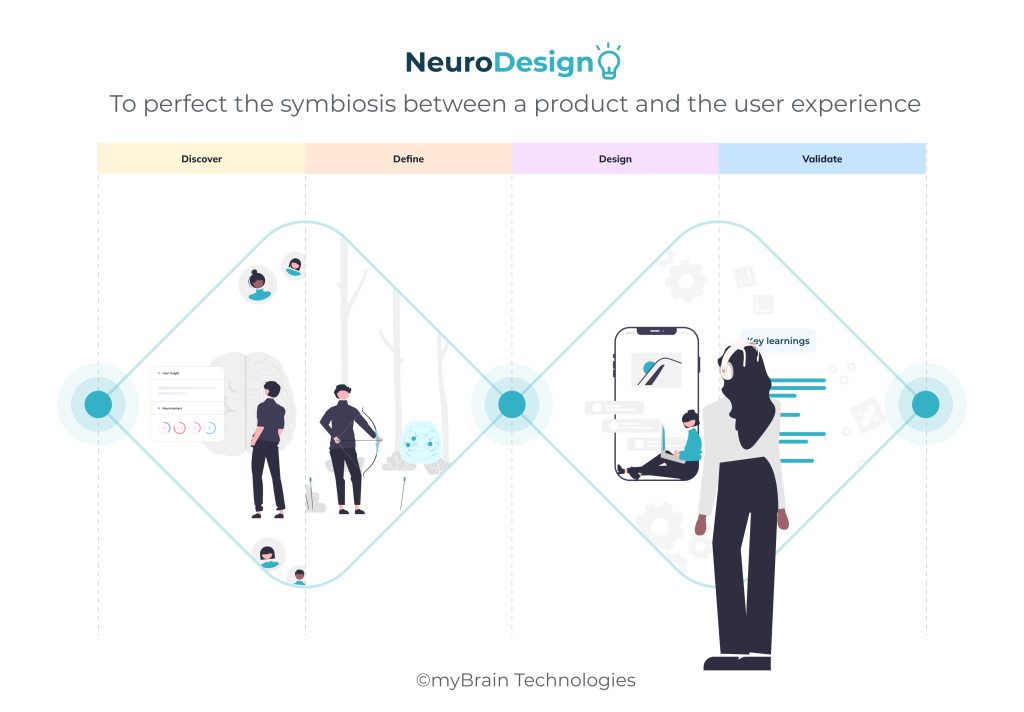
NeuroAeronautics: brain wave monitoring in the ‘Cockpit of the Future’.
By Vivian Panah Izadi.

Neuroergonomics is a key factor in shaping the ‘Cockpit of the Future’. A cockpit is a highly sensitive area, where attention and mental workload have to be optimized. In flight, a mental workload that is too heavy will mobilize all of the pilot’s cognitive resources and thus expose them to potential danger when an unexpected event occurs. Latest ‘out of the lab’ neuroscience technologies, including EEG, can track brain activity and offer neuroadaptive solutions to limit cognitive interference for safer and better operational performance.
The problem with high mental workload.
There are specific networks in the brain dedicated to attentional regulation (e.g. alertness, orientation, concentration). This mechanism ensures an optimal trade-off between attentional strategies and conditions of high task demand. Unfortunately, in conditions of stress or fatigue, the mechanism may be biased and lead to certain fluctuation of attentional phenomena such as inflexibility, mental wandering, spontaneous thoughts or disengagement.
High mental load leads to decreased performance, not because of limited resources but because of inhibitory neural mechanisms (cf. « lateral inhibition » or « inhibitory control ») designed to give priority to a specific goal or directive. These mechanisms result in a decrease in the brain’s ability to consider new or alternative information, thus leading to diminished vigilance and increased risk.
Performance monitoring offers insight into the underlying mechanism of mental workload and attention. There is evidence that an increased probability of failure is associated with deactivation of the prefrontal cortex for operational performances where failure can jeopardize the safety of self and others (Dehais & al., 2020)[1]. The brain (prefrontal cortex) is capable of monitoring performance quality and progress toward task goals during operational performance only in certain conditions. An increased probability of failure may elicit strong emotional responses associated with stress and cognitive interference.
Tracking brain state during flight simulation.
New affordable wearable EEG recording devices provide measures about psychological internal states with high reliability in signal recording and data processing. They have a large range of future applications in environments such as automotive simulators, aircraft’s cockpits, or even in control rooms. Integrated systems can be designed to monitor the actual user’s instant brain state, and truly become an in-flight pilot aid to make informed decisions according to real-time needs and intentions.
Neuroergonomics offers insights into the real-life study of the cognitive and emotional response of a product. The interpretation of EEG signals which describe the stress and attention levels of the users can be used to test and optimize the ergonomic design of spaces. In the figure below the green zone conceptually describes the operator’s “comfort zone” where performance is optimal. The degraded mental states are mapped across a “task engagement” axis and an “arousal” axis. Interestingly, this point of view makes it possible to measure the human response to stimuli in a real life setting. The three possible pitfalls of attention are perseveration, mind wandering and effort withdrawal. The manufacturer must avoid these pitfalls in order to optimize cockpit performance.

A new typology of neuroadaptive countermeasures is now available to mitigate undesirable mental conditions in cockpit pilots. The neural mechanisms underlying the relationship between task demand, arousal, mental load and human performance inform us on the mental states that precede a decrease in performance. Thanks to advances in neuroergonomics, the understanding of neurocognitive processes in disciplines where critical human behavior can impact safety (e.g. aeronautics) is expanded. Real time EEG monitoring will improve and modulate the interaction between the operator and the system itself, in order to reduce stress and mental workload in pilots and increase vigilance.
Neuroadaptation applications to in-flight performance.
The study of mental workload serves primarily to predict the probability of performance degradation during operational scenarios, which may be safety critical. In order to quantify the transaction between operators and a range of task requirements some technological systems can take over during operational protocols of in-flight simulation.
Adaptive Automation (AA) would allow to maintain the mental load demand at appropriate levels (i.e. avoid overload and underload), thus improving the performance and safety of the human-machine system. The use of AA requires knowing when and how to trigger it without affecting the operational task. For this purpose, passive brain-computer interface (pBCI) systems are good candidates because they are able to collect information about the hidden behavior of a subject by analyzing its neurophysiological signals and without interfering with the execution of the current task.

The pBCI systems recognize the spontaneous brain activity of the user related to the considered mental state (e.g. emotional state, mental load, attention levels), and uses this information to improve and modulate the interaction between the operator and the system itself. In the context of AAs, pBCIs perfectly match the system’s needs in terms of Human-Computer Interaction (Parasuraman & al., 1992[3]; Zander & Jatzev, 2012[4]). The Workload EEG refers to the measured brain activity index of a user during a difficult task. Latest EEG sensor studies have shown an inverse relationship between Adaptive Automation and Workload EEG. Adaptive Automation refers to the process of entirely or partially allocating activities constituting a task usually performed by a human, to a machine or a system.
In conclusion.
Latest ‘out of the lab’ neuroscience technologies have huge transformational potential in the aviation industry. Neuroadaptive solutions offer promising prospects for mitigating the onset and likelihood of adverse neurocognitive phenomena during in-flight conditions for pilots. These technologies have their place both in conception design (monitoring human interactions with cockpit interface) and in tracking pilot brain states to alleviate the mental workload index. Soon, it will be possible to track the mental workload of a team of pilots during in-flight simulation and assess which pilot is in the fittest condition to operate an aircraft at a specific time. Continuous monitoring of brain waves can drive the level of automation and optimize the user’s level of engagement in the task, thus increasing vigilance and limiting in-flight risks.
References.
[1] Dehais, F., Lafont, A., Roy, R., & Fairclough, S. (2020). A Neuroergonomics Approach to Mental Workload, Engagement and Human Performance. Front. Neurosci. 14:268. doi: 10.3389/fnins.2020.00268
[2] Aricò, P., Borghini, G., Di Flumeri, G., Colosimo, A., Bonelli, S., Golfetti, A., Pozzi, S., Imbert, J. P., Granger, G., Benhacene, R., & Babiloni, F. (2016). Adaptive Automation Triggered by EEG-Based Mental Workload Index: A Passive Brain-Computer Interface Application in Realistic Air Traffic Control Environment. Front. Hum. Neurosci. 10:539. doi: 10.3389/fnhum.2016.00539
[3] Parasuraman, R., Bahri, T., Deaton, J. E., Morrison, J. G., & Barnes, M. (1992). Theory and Design of Adaptive Automation in Aviation Systems. Warminster, PA: Naval Air Warfare Center; Aircraft Division.
[4] Zander, T. O., & Jatzev, S. (2012). Context-aware brain-computer interfaces: exploring the information space of user, technical system and environment. J. Neural Eng. 9, 16003. doi: 10.1088/1741-2560/9/1/016003.
Related Articles

A milestone for NeuroEthics
Neurotechnologies are no longer confined to research laboratories. They are fully integrated in our societies, whether in the medical field or beyond.

The benefits of collecting EEG neuroimaging insights in clinical trials.
In clinical trials, brain monitoring EEG is facilitating the measurement of complex clinical endpoints. EEG as a biomarker provides safe, objective an

Newsletter | December 2022.
During this year of 2022, we have dedicated ourselves to make our solution more complete and ergonomic through many updates designed to optimize th

Newsletter | November 2022.
The end of 2022 marks a major step forward in the neurotechnology sector in France: the presentation of a Charter for a responsible development of ne

A milestone for NeuroEthics.
The capacity of neurotechnologies to probe and interfere with brain activity challenges notions of identity, integrity and autonomy of human being. Re

Newsletter | October 2022.
To travel miles in full peace of mind, in a car that understands and anticipates every need of the driver on the road, is becoming a reality! With it

Newsletter | September 2022.
myBrain Technologies is committed to provide the most accurate offer possible to support its customers in the development of their products. With the

Newsletter | Summer 2022.
Statistics are here! Discover now our new statistic tools in Analytics to easily interpret your protocol results. Easily navigate, clearly see and qu

Newsletter | June 2022.
As a company that has developed a solution based on Artificial Intelligence (AI) and neuroscience ans as manufacturer of Medical Devices (MD), myBrain
![[DOWNLOAD] Artificial Intelligence Act: What future for AI in Europe?](https://emmanuel-guerin.fr/dev-mybraintech/wp-content/uploads/2022/06/white-paper-artificial-intellifence-act.png)
[DOWNLOAD] Artificial Intelligence Act: What future for AI in Europe?
With the increasing evolution of computing, robotics, and new technologies, AI is now a major part of our daily life. On April 21, 2021, the European

myBrain Technologies’s eye on Medical Device Regulation.
In order to improve health safety and harmonize rules within the EU, the Medical Device Regulation has been profoundly revised, resulting in new regul

Newsletter | May 2022.
Our brain still holds many secrets, both in its functionning and in its normal development. Thanks to the latest neurosciences techniques and tools, i

NeuroAeronautics: brain wave monitoring in the ‘Cockpit of the Future’.
A cockpit is a highly sensitive area, where attention and mental workload have to be optimized. Latest neurotechnologies, including EEG, can track bra

Newsletter | April 2022.
This month, the spotlight is on user experience that our Product Team keep on improving. We aim to focus on our customer's feedback to optimize our so

NeuroDesign: to perfect the symbiosis between a product and the user experience.
One of the key aspects of product strategy is to generate, identify and leverage insights that will provide the foundation to reach business objective

Newsletter | March 2022.
Hi there! The cosmetic industry has been interested for a while in exploring the links between the brain and the nervous system. The recent advances i

NeuroCosmetics in skincare.
Cutting edge “neuro-IA” technologies can detect the physiological impact of a cosmetic product using real-time consumers’ emotional data collect

Newsletter | February 2022.
First of all, we're deeply happy to have seen so many of you reading us last month and we thank you very much! Today, we are proud to announce that o

Neuroergonomics: towards a new paradigm of product design.
Neuroergonomics provides a multidisciplinary approach that merges elements of neuroscience, human factors, and ergonomics to study brain response to s

Newsletter | January 2022.
2021 has been full of exciting happenings. Since the very beginning of our adventure, we are dedicated to improve the life of others with neuroscienc

Press Release: Decoding the brain to understand human cognition and emotions.
myBrain Tech has developed its Neuromarkers platform to record, analyze and interpret the brain's electrical signals in real time. With this solution,

[SAVE THE DATE] – AI, conquering emotions in Health!
On Tuesday, November 16, 2021, at 11am, come and listen to Giuseppe Spinelli at the microphone of Pascal Becache on the occasion of the 4th Webinar #P

Computational Psychiatry: how neurotechnology is changing the world of mental health ?
Neuroscience and artificial intelligence are about to revolutionize medicine, especially psychiatry. Neurotechnologies offer a range of new tools base

The path to ISO 13485.
Implementing a quality approach within a start-up poses particular difficulties linked to the context of innovation, agility and rapid growth. However
Get in touch
We are glad you are interested in reaching out to us. Whether you have a question about our products or want to give us feedback, we are here to help.

Laisser un commentaire